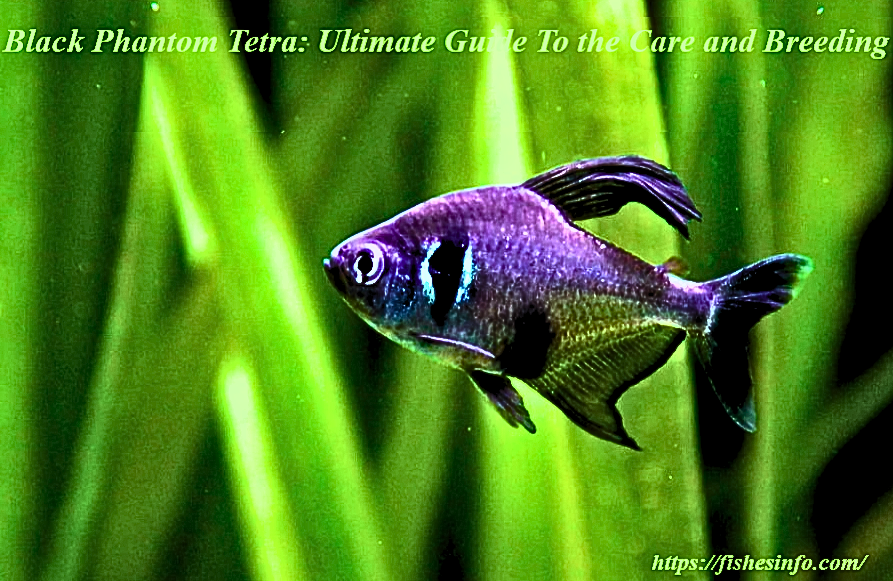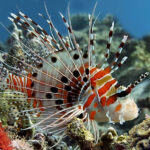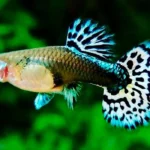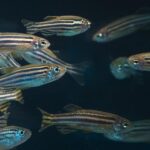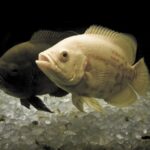Introduction
Black Phantom Tetra, a panoramic species known for its striking appearance and peaceful nature, is a popular alternative among aquarists who want to add color and activity to their tanks. In this broad guide, we will participate in the care and breeding of Black Phantom Tetras, from creating an ideal tank environment to understanding everything about the dietary needs and health ideas. Whether you are an early or an experienced fish keeper, the purpose of this article is to provide valuable insights and tips to help you make sure that these beautiful teters in your aquarium.

Black phantom tetras are small and charismatic freshwater fish that create a wonderful addition to any aquarium. Known for its striking black color and specific neon symbols, these tetras are popular with their peaceful nature and amateurs for active behavior.
Overview of Black Phantom Tetras
Black Phantom Tetras, scientifically known as binding megalopterus, are a resident in South America, especially Brazil and Paraguay. They are a school fish species, so it is best to place them in groups of six or more to ensure their good health and happiness in the aquarium.
Classification:
- Scientific Name: Hyphessobrycon megalopterus
- Family: Characidae
- Origin: South America (Brazil & Bolivia)
- Size: Up to 1.5 inches (4 cm)
- Lifespan: 5-6 years
- Temperament: Peaceful, schooling fish
- Diet: Omnivore
- Ideal Tank Size: 20 gallons or larger
- Water Parameters: pH 6.0-7.5, Temperature 72-82°F (22-28°C
Historical Background and Characteristics
For the first time in the early 20th century, Black Phantom Tetras have since become a hit in the hobbyist fishing community. His jet-black body adorned with vibrant red signs gives them a mysterious and captivating appearance, making them a favorite among the aquarists who are looking for the touch of elegance to their tanks.
Setting Up the Ideal Tank Environment
Providing a proper habitat for Black Phantom Tetras is important for their longevity and well-being. Tank size to lighting, every element of their environment is important in making their lives healthy.
Selecting the Proper Tank Size
As far as tank size goes, go for at least 20 gallons for a small school of Black Phantom Tetras. Giving them enough room provides these active fish with the space to swim and explore without stress, encouraging natural behavior.
Decor and Substrate Options
Black Phantom Tetras enjoy densely planted aquariums with many hiding places. Use soft, dark substrates such as sand or small-grain gravel to simulate their natural environment. Driftwood, rocks, and live plants not only add aesthetic value to the tank but will also provide shelter and breeding grounds for the tetras.
Lighting and Filtration Requirements
Moderate to low light is best for Black Phantom Tetras, as it simulates their naturally dimly-lit waters. A good filtration system is needed to keep the water clean and deliver the required oxygen levels for the fish. A gentle filter flow should be used to avoid stressing the fish and allow the tetras to swim easily.

Black Phantom Tetra Diet and Feeding Tips
Proper nutrition is important to keep black Fantom Tetras healthy and vibrant. Understanding the dietary needs and offering a diverse diet is necessary for their general welfare.
Black phantom to understand the dietary requirements of Tetras
Black Phantom Tetras are ubiquitous, which means they require a mixture of plant cases and protein in the diet. In nature, they feed on small insects, algae, and organic debris. Repeat this diet in captivity by offering a combination of high quality layers, pills, frozen and live foods.
Recommended foods and feeding plan
Provide a balanced diet that includes quality flakes or pellets such as staple food. The added protein complements its diet with living or frozen foods such as bloodworm, brine shrimp, and daphnia. Feed your Black Phantom Tetras several times a day several times a day, making sure they use all foods in minutes to prevent problems with overprinsing and water quality.
Water quality and maintenance for healthy tetras
It is necessary to maintain the old water condition for health and life for black Fantom Tetras. Regular water testing and maintenance routine are important to create a rich aquatic environment for these beautiful fish.
The importance of water parameters
Black phantom tetras thrive slightly in acidic to neutral water with a temperature range of 23-28 °C. Monitor main parameters such as pH, ammonia, nitrite, and nitrate levels to ensure they fall within the recommended boundaries. Constant water quality promotes good health and vibrant color in these tetras.
Regular water testing and maintenance work
Invest in a reliable water test set to monitor regular water parameters. Make partial water changes of 20-30% every 1-2 weeks to remove and fill accumulated waste.
Recommended For You>><< Robalo Fish Biology, Ecology, Conservation and Recipe
Breeding Black Phantom Tetras: Tips and Techniques
Creating the Right Breeding Conditions
Black Phantom Tetras can be a rewarding experience for breeding aquarists. To encourage breeding, provide a separate reproductive tank with slow light and dense vegetation for tetracy. Around 6.5–7.0, maintain stable water position with slightly acidic pH and a temperature of 75–80 ° F.
Spawning Behavior and Care of Fry
During the splash, the male will chase the female, and the female will spread the glue walls between the plants. After shooting, remove adults to prevent them from eating eggs. Eggs will hatch in 24-36 hours, and the roosters can feed infusoria or commercial liquid food until they are large enough to eat crushed layers.
Common Health Issues and How to Address Them
Identifying Signs of Illness in Black Phantom Tetras
Like all fish, Black Phantom Tetras are susceptible to various health issues. Watch for signs of common ailments such as white spots (ich), fin rot, or parasites. Symptoms may include lethargy, loss of appetite, or abnormal swimming behavior.
Treatment Options and Preventative Measures
If you notice any signs of illness, quarantine the affected fish to prevent the spread of disease. Treat with appropriate medication following manufacturer instructions. To prevent health issues, maintain good water quality, perform regular water changes, and avoid overcrowding the tank.
Compatible Tankmates and Ideal Tank Setup
Choosing Suitable Tankmates for Black Phantom Tetras
Black Phantom Tetras are peaceful community fish suitable for a variety of tankmates, such as other tetras, rasboras, and peaceful bottom-dwellers like Corydoras catfish. Avoid aggressive or fin-nipping species that may stress the tetras.
Aquascape Ideas for a Harmonious Community Tank
Create a naturalistic environment with live plants, driftwood, and rocks to mimic the tetras’ natural habitat. Provide hiding spots and open swimming areas. Ensure the tank is well-filtered and maintain stable water parameters to promote overall tank health.

Tips for Enhancing the Wellbeing of Black Phantom Tetras
Whether you’re a seasoned aquarist or new to the hobby, keeping Black Phantom Tetras can be a delightful experience. To enhance their wellbeing, provide a varied diet of high-quality flakes, pellets, and frozen foods. Monitor water parameters regularly and perform routine maintenance to keep your tetras happy and healthy. Remember, a happy tetra is a colorful tetra!
Conclusion
In conclusion, Black Phantom Tetras care and breeding can be a rewarding and pleasant experience for fishing enthusiasts at all levels. By following the guidelines mentioned in this final guide, you can create a prosperous environment for your tetras, promote their health and well-being, and possibly see the attractive process of fertility. Remember to learn and continue to learn for your Black Phantom Tetra’s needs, and your efforts will be rewarded with a vibrant and harmonious aquarium ecosystem. Happy Fish-Keeping!
Frequently Asked Questions (FAQ)
1. How often should I feed my Black Phantom Tetras?
You should feed Black Phantom Tetras 2-3 times a day, offering only as much food as they can consume within 2-3 minutes. Their diet should be balanced, including high-quality flakes or pellets, live or frozen foods (like brine shrimp and bloodworms), and occasional plant-based options (such as blanched spinach or spirulina flakes).
2. Can Black Phantom Tetras live with other fish species?
Yes, Black Phantom Tetras are peaceful and social fish that thrive in community aquariums. They should be kept in schools of at least six and can coexist with other peaceful, similarly-sized fish.
Best Tank Mates:
- Other Tetras (Neon Tetras, Rummy Nose Tetras, Ember Tetras)
- Small Peaceful Fish (Guppies, Mollies, Platies)
- Bottom Dwellers (Corydoras Catfish, Kuhli Loaches, Otocinclus)
- Dwarf Cichlids (German Blue Ram, Apistogramma)
Tank Mates to Avoid:
- Aggressive or Large Fish (Oscars, Jack Dempseys, Large Cichlids)
- Fin-Nipping Species (Tiger Barbs, Certain Betta Fish)
3. What are some common health issues that Black Phantom Tetras may face, and how can they be treated?
Despite being hardy fish, Black Phantom Tetras can suffer from common freshwater diseases. Here are some common health issues and treatments:
-
Ich (White Spot Disease)
- Symptoms: Small white spots on the body and fins, rubbing against objects.
- Treatment: Increase water temperature to 82°F (28°C), add aquarium salt, or use Ich medication.
-
Fin Rot
- Symptoms: Torn or discolored fins, lethargy.
- Treatment: Improve water quality, add antibacterial medication, and avoid overcrowding.
-
Swim Bladder Disease
- Symptoms: Difficulty swimming, floating upside down, sinking to the bottom.
- Treatment: Feed a blanched pea (to relieve constipation) and avoid overfeeding.
-
Fungal Infections
- Symptoms: White cotton-like growth on body or fins.
- Treatment: Use antifungal medication and keep the water clean and stable.
4. What are the key differences between male and female Black Phantom Tetras?
Males:
- Have longer, more pronounced dorsal and anal fins.
- Display a more intense black eye patch.
- Engage in mock fights, spreading their fins in a non-aggressive display.
Females:
- Have a rounder, plumper body, especially when carrying eggs.
- Possess a reddish tint on their pelvic and anal fins.
- They are generally less active in territorial displays compared to males.
